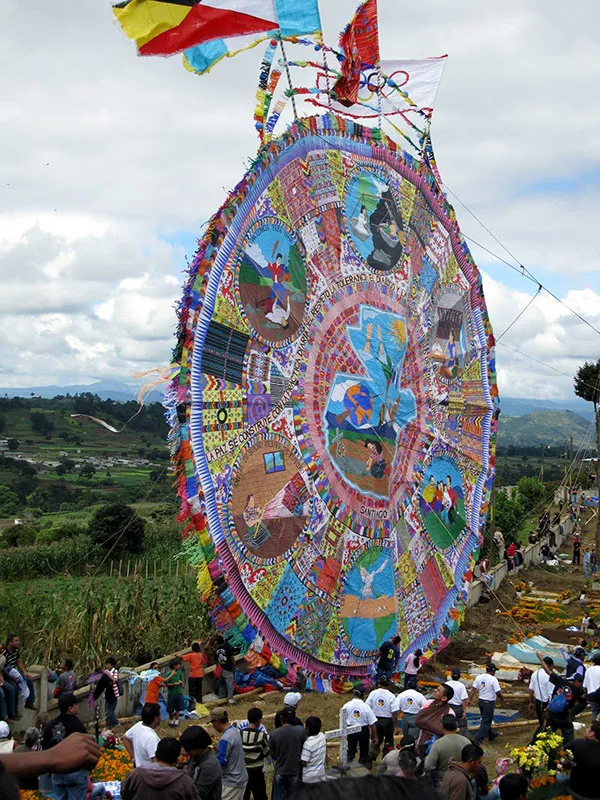
November first and second rest at “cross-corners” in the solar calendar, falling halfway between the autumn equinox and the winter solstice. Many cultures mark this juncture. Celtic peoples celebrate Samhain, when the veil between our world and that of the departed becomes thin. This, filtered through Catholic lenses, becomes Halloween (All Hallows' Eve). The Catholic Church observes All Saints' Day followed by All Souls'. Mayan peoples go to the cemeteries to commune with their family members who have passed on. Part of the communion traditionally involves flying kites, which bear messages. In Pa K'im (Santiago Sacatepéquez) kite-making evolved from simply stretching banana leaves over cane withes and attaching prayers, greetings, and requests as the cloths in the tail, to constructing mammoth works of art from tissue paper and cane trunks. In 1899, groups of young men in Pa K'im took their craft beyond the scope of 1-2 meter diameter creations to 5-6 meter giants. Since that time their work has become known throughout Guatemala, attracting national and international visitors. Not surprisingly, the neighboring community of Sumpango has begun, likewise, to make gargantuan kites, though they no longer attach spiritual significance to them, holding the exhibition/competition in the municipal soccer field rather than in the cemetery. The Pa K'im celebration, in contrast, continues to be held in the cemetery and includes smaller kites, still capable of flying, as well as the huge exemplars.
My friend, Aq'ab'al Ticun, is from Pa K'im and invited me to stay at his place during the festival. I arrived along with his other three guests on October 31st. It was raining and power had failed in the city. We rode into a coal-black town and groped our way down the precipitous sidewalk to Aq'ab'al's door. Soon we had candles lit and a cheerful glow combated the exterior's cold dark. We were supposed to go out to the graveyard and dance. There was a marimba playing, which could be heard faintly in the distance. Still the rain and cold put a damper on that idea and we elected to stay in cozily clustered around the candles, drinking hot chocolate and, in some cases, tequila. I called it a night when it seemed that the rain was determined to see it through to dawn. I miscalculated, however; the rain let up at midnight, so those still sentient went out to the cemetery and danced for a couple of hours.
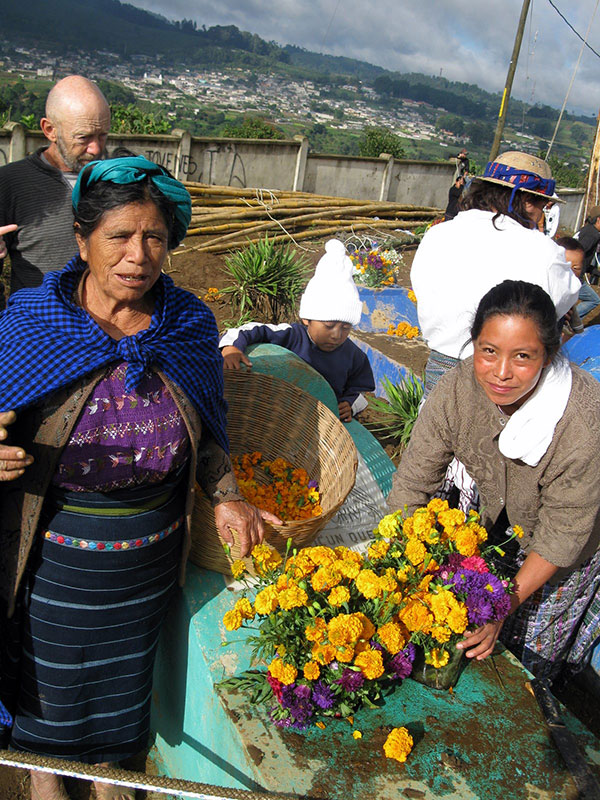
This made for some tired folks at dawn on November first, when we got up and got ready to go adorn the graves. The principal flower offered is the marigold, parutz' in Kaqchikel, flor de muerto in local Spanish. We went out with Aq'ab'al's family, visiting the graves of their dead. The grave mounds had already been cleaned of weeds and packed tightly to withstand the pounding they would get as people danced, visited, or raced to elevate kites. Each of Aq'ab'al's family graves had a single maguey planted at one end, symbolizing remembrance and rejuvenation. Many other graves in the cemetery had these lone succulents rising from one end. Later in the day, these proved to be hazards for the kites that didn't quite get airborne, the sharply pointed maguey leaves shredding crashing tissue-paper fliers.
At the last set of graves, Aq'ab'al's great-grandfather and grandfather, we shared a snack: banana bread and grapes. Each grave received a serving and we all ate with them there. Next to these graves a team of young men was assembling the bamboo framework that would hold one of the giant kites. When we had all eaten, Aq'ab'al asked me to share the remaining bread with them. They solemnly accepted the communion and then quickly resumed work on their scaffolding. We went back to the house for breakfast. The roadway leading to the graveyard was teeming with visitors and with vendors. Foodstalls offered boiled and roasted corn, sweet-corn tamales, tamales of much' (…., a wonderful legume I wish we had in the US), all sorts of grilled meats, candies, pizza (whole or by the slice), boiled merlitons, and assorted fruit (fresh and candied). Cotton candy filled the air with the luscious odor of empty calories. Other peddlers offered handicrafts, small fly-able kites, jewelry, pirated CDs and DVDs, and souvenirs. Carnies offered “sure-win” kick-the-ball games.
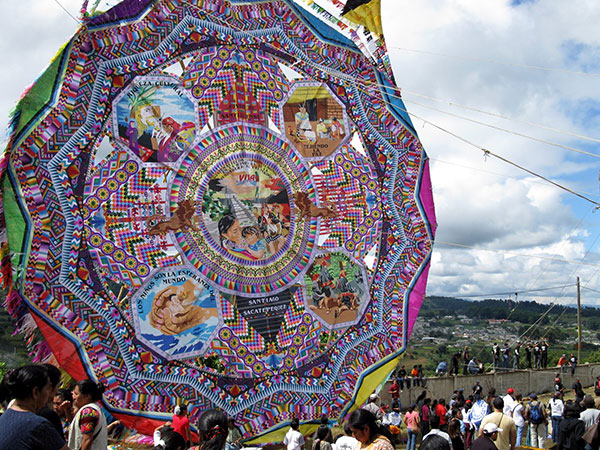
By the time we returned to the burial ground after breakfast, the road was as packed as Bourbon on Mardi Gras, post-parades. Two of the giant kites had already been erected and were firmly secured to their support beams. They were breath-taking. All the designs are created by cutting and pasting tissue paper in the required forms, but from a distance, the mosaic appears a painted masterpiece. Each kite represents the labor and creativity of a krewe of young men, working nights throughout six or seven months. Few girls or women participate, as they would have to be away from the hearth-hold at night, and because it requires a lot of strength to assemble the scaffolding and then hoist it.
Each kite also presents a message. The smaller kites, those that can fly, carry messages for the ancestors, implanted through prayer and concentration. The colossal kites likewise communicate with the spirits, but also with the host of visitors to the graveyard. Most are calls to conscience: prayers for peace, prayers for respect for Nature, injunctions to eschew daily violence, calls to conserve tradition, to build stronger family ties, to promote educational opportunities, to live in beauty. The materials for each giant kite run to nearly Q10,000-Q15,000 ($1,250-$1,875); each krewe seeks sponsors to help with the purchase of supplies. These sponsors are usually recognized by emblematic flags, which fly atop the kites. This year, Panasonic, subsidized a 2 meter, flyable kite; they were rewarded with their logo splashed across the face of the kite.
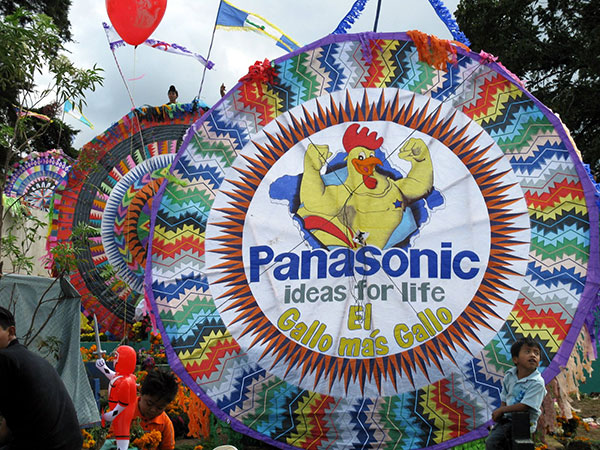
One by one other colossal kites were elevated. The krewes often collaborated in hauling on the hawsers to bring the huge frames up off the ground. One team, positioned fifth, in the line, found themselves unable to erect their kite next to the support pole they had sunk at dawn, and over the crux of which they had strung their pulley work. The guy-lines from the sixth kite, already raised and firmly secured, blocked the last 30-degree angle of elevation for number 5. Rather than loosen the blocking guy temporarily, team 5 raced to get a new support pole, quickly finding a log with a forked top. This log was only about 9 feet long, much shorter than the normal poles used, but they quickly dug a posthole and inserted it. They also inserted several smaller bamboo rods along a baseline, to provide a pivot point for pulling the kite up. Once all was in place, they called on brother krewes for back-power and started to hoist. The newly-sunk pulley pole could not take the strain and quickly tilted back, leaving the young men to fight gravity with no elevated fulcrum point. The kite sighed and slipped backward, the delicate rim shredding against the baseline bamboos. Unwilling to let six months of work simply rest facedown, the krewes strained against their ropes and the kite came up, its edges badly chewed and some of the artwork ripped, but erect.
Once the giant kites were in place, judging began. The top two kites would be saved and exhibited in Guatemala City. The next runner-up would be shown in the town center. The others would, according to the tradition with All Saints'/All Souls' kites, would be burned. These kites not only communicate with the spirits, but help protect them, absorbing negative energies. These energies are then consigned to the fire, cleansing the area for another year.
After the judging, other young men began to fly smaller kites. Teenagers worked in teams of 7-8 to loft 2-meter kites. Children flew smaller foot-wide kites. The government gave kids kites at the graveyard entrance, in the national colors, light-blue and white. Teams of young men ran across the graves pulling yards of string. Children stood on crypts and tossed their small kites aloft. Little wind was blowing, but some kites got aloft and flew throughout the afternoon, communing with the ancestors. Throughout the day, vendors plied the crowds, hawking water, soft drinks, peanuts, and ice cream. The ice cream vendors push small cold-box-carts, each equipped with a cowbell, that became the counterpoint to the background marimba.
As dusk fell, we watched sadly as one after another the great kites were lowered to the ground, their frames unlashed, flags furled, and the tissue mosaic of hopes and challenges burned. The few that were to be saved for exhibit, where carefully folded and encased in plastic tarps. The kite-flyers lowered and burned their creations as well. Only those that had not taken messages aloft were to be saved to fly on All Souls'. The marimba, playing at the cemetery entrance, was still going strong as dusk darkened into night. A few couples danced, and the party with the ancestors continued.
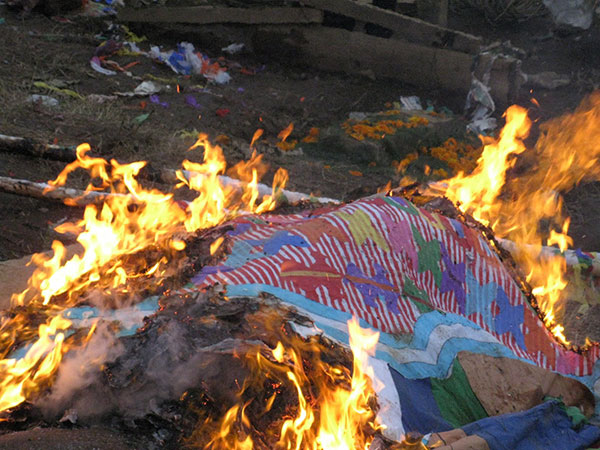
I went home to supper in a kitchen, warmed by the woodstove's fire, and to rest. All Souls' is dedicated to the flying of communicative kites. The huge banner kites are all gone, either up in smoke or off to exhibit halls, wrapped in plastic. However, All Souls' dawned rainily. I kept starting to leave the house to get up to the graveyard and turning back as misting turned to sprinkles and then rain, but finally, I decided to just go. Most of the knick-knack vendors had departed, leaving locals purveying foodstuffs along the cemetery road. The marimba at the graveyard entrance had been replaced by a DJ blasting CDs through huge speakers. Several teams of young men had 2-meter kites ready to fly, just waiting for a break in the drizzle. However, as soon as I entered the burial grounds the clouds broke open. Everyone ran for cover. One krewe, unable to get their kite under an awning, covered it with a tarp and then sheltered in its lee. When the rain let up, they uncovered their masterpiece, but the damp had seeped around the edges and the tissue was too sodden and torn to hold wind and fly. Smaller kites rose sluggishly in the air, only to be driven down by mist and lack of wind. A few teams of young men hung in sheltered alcoves, their kite tissue-creations carefully folded and kept in plastic bags, cane poles, kite-tails, and string at the ready, hoping for a break in the weather. Most, like me, soon left to return home.
The kites will fly twice more, in mid-November, and then will be consigned to ashes.

